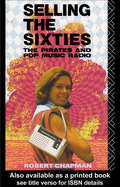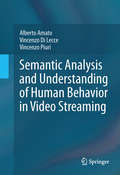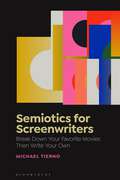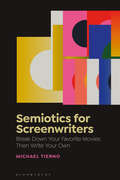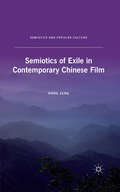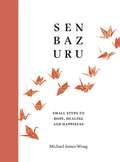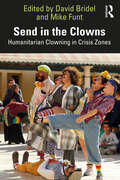- Table View
- List View
Selling the Sixties: The Pirates and Pop Music Radio
by Robert ChapmanWas it a non-stop psychedelic party or was there more to pirate radio in the sixties than hedonism and hip radicalism? From Kenny Everett's sacking to John Peel's legendary `Perfumed Garden' show, to the influence of the multi-national ad agencies, and the eventual assimilationof aspects of unofficial pop radio into Radio One, Selling the Sixties examines the boom of private broadcasting in Britain. Using two contrasting models of pop piracy, Radios Caroline and London, Robert Chapman sets pirate radio in its social and cultural context. In doing so he challenges the myths surrounding its maverick `Kings Road' image, separating populist consumerism from the economic and political machinations which were the flipside of the pirate phenomenon. Selling the Sixties includes previously unseen evidence from the pirates' archives, revealing interviews and an unrivalled selection of rare audio materials.
Selling the Splat Pack: The DVD Revolution and the American Horror Film
by Mark BernardThis study reveals the history of how the emergence of the DVD market changed cultural and industrial attitudes about horror movies and film ratings. These changes made way for increasingly violent horror films, like those produced by the Splat Pack, a group of filmmakers who were heralded in the press as subversive outsiders. Taking a different tack, this study proposes that the films of the Splat Pack were products of, rather than reactions against, film industry policy. It blends study of the film industry with analysis of films such as the Saw and Hostel franchises.
Selling the Splat Pack: The DVD Revolution and the American Horror Film (Edinburgh University Press)
by Mark BernardWhat was really responsible for the influx of violent horror movies like Saw and Hostel? Selling the Splat Pack reveals the secret history of how the DVD market changed horror movies and film ratings. These changes made way for horror films like those by the ‘Splat Pack’, a group of directors including Eli Roth, Rob Zombie and James Wan. This book re-examines the history of the American horror film from a business perspective and explores how DVD influenced the production of American horror films during the first decade of the 21st century.
Selling Your Crafts at Craft Shows: Storey's Country Wisdom Bulletin A-156 (Storey Country Wisdom Bulletin)
by Madelaine GraySince 1973, Storey's Country Wisdom Bulletins have offered practical, hands-on instructions designed to help readers master dozens of country living skills quickly and easily. There are now more than 170 titles in this series, and their remarkable popularity reflects the common desire of country and city dwellers alike to cultivate personal independence in everyday life.
Semantic 3D Object Maps for Everyday Robot Manipulation (Springer Tracts in Advanced Robotics)
by Radu Bogdan RusuThe book written by Dr. Radu B. Rusu presents a detailed description of 3D Semantic Mapping in the context of mobile robot manipulation. As autonomous robotic platforms get more sophisticated manipulation capabilities, they also need more expressive and comprehensive environment models that include the objects present in the world, together with their position, form, and other semantic aspects, as well as interpretations of these objects with respect to the robot tasks. The book proposes novel 3D feature representations called Point Feature Histograms (PFH), as well as a frameworks for the acquisition and processing of Semantic 3D Object Maps with contributions to robust registration, fast segmentation into regions, and reliable object detection, categorization, and reconstruction. These contributions have been fully implemented and empirically evaluated on different robotic systems, and have been the original kernel to the widely successful open-source project the Point Cloud Library (PCL) -- see http://pointclouds.org.
Semantic Analysis and Understanding of Human Behavior in Video Streaming
by Alberto Amato Vincenzo Di Lecce Vincenzo PiuriSemantic Analysis and Understanding of Human Behaviour in Video Streaming investigates the semantic analysis of the human behaviour captured by video streaming, and introduces both theoretical and technological points of view. Video analysis based on the semantic content is in fact still an open issue for the computer vision research community, especially when real-time analysis of complex scenes is concerned. This book explores an innovative, original approach to human behaviour analysis and understanding by using the syntactical symbolic analysis of images and video streaming described by means of strings of symbols. A symbol is associated to each area of the analyzed scene. When a moving object enters an area, the corresponding symbol is appended to the string describing the motion. This approach allows for characterizing the motion of a moving object with a word composed by symbols. By studying and classifying these words we can categorize and understand the various behaviours. The main advantage of this approach lies in the simplicity of the scene and motion descriptions so that the behaviour analysis will have limited computational complexity due to the intrinsic nature both of the representations and the related operations used to manipulate them. Besides, the structure of the representations is well suited for possible parallel processing, thus allowing for speeding up the analysis when appropriate hardware architectures are used. A new methodology for design systems for hierarchical high semantic level analysis of video streaming in narrow domains is also proposed. Guidelines to design your own system are provided in this book. Designed for practitioners, computer scientists and engineers working within the fields of human computer interaction, surveillance, image processing and computer vision, this book can also be used as secondary text book for advanced-level students in computer science and engineering.
Semantic Multimedia Analysis and Processing (Digital Imaging and Computer Vision #9)
by Evaggelos SpyrouBroad in scope, Semantic Multimedia Analysis and Processing provides a complete reference of techniques, algorithms, and solutions for the design and the implementation of contemporary multimedia systems. Offering a balanced, global look at the latest advances in semantic indexing, retrieval, analysis, and processing of multimedia, the book features the contributions of renowned researchers from around the world. Its contents are based on four fundamental thematic pillars: 1) information and content retrieval, 2) semantic knowledge exploitation paradigms, 3) multimedia personalization, and 4) human-computer affective multimedia interaction. Its 15 chapters cover key topics such as content creation, annotation and modeling for the semantic web, multimedia content understanding, and efficiency and scalability. Fostering a deeper understanding of a popular area of research, the text: Describes state-of-the-art schemes and applications Supplies authoritative guidance on research and deployment issues Presents novel methods and applications in an informative and reproducible way Contains numerous examples, illustrations, and tables summarizing results from quantitative studies Considers ongoing trends and designates future challenges and research perspectives Includes bibliographic links for further exploration Uses both SI and US units Ideal for engineers and scientists specializing in the design of multimedia systems, software applications, and image/video analysis and processing technologies, Semantic Multimedia Analysis and Processing aids researchers, practitioners, and developers in finding innovative solutions to existing problems, opening up new avenues of research in uncharted waters.
Semantic Multimedia Analysis and Processing (Digital Imaging and Computer Vision)
by Evaggelos Spyrou Dimitris Iakovidis Phivos MylonasBroad in scope, Semantic Multimedia Analysis and Processing provides a complete reference of techniques, algorithms, and solutions for the design and the implementation of contemporary multimedia systems. Offering a balanced, global look at the latest advances in semantic indexing, retrieval, analysis, and processing of multimedia, the book features the contributions of renowned researchers from around the world. Its contents are based on four fundamental thematic pillars: 1) information and content retrieval, 2) semantic knowledge exploitation paradigms, 3) multimedia personalization, and 4) human-computer affective multimedia interaction. Its 15 chapters cover key topics such as content creation, annotation and modeling for the semantic web, multimedia content understanding, and efficiency and scalability. Fostering a deeper understanding of a popular area of research, the text: Describes state-of-the-art schemes and applications Supplies authoritative guidance on research and deployment issues Presents novel methods and applications in an informative and reproducible way Contains numerous examples, illustrations, and tables summarizing results from quantitative studies Considers ongoing trends and designates future challenges and research perspectives Includes bibliographic links for further exploration Uses both SI and US units Ideal for engineers and scientists specializing in the design of multimedia systems, software applications, and image/video analysis and processing technologies, Semantic Multimedia Analysis and Processing aids researchers, practitioners, and developers in finding innovative solutions to existing problems, opening up new avenues of research in uncharted waters.
Semantic Multimedia and Ontologies: Theory and Applications
by Yiannis Kompatsiaris Paola HobsonThis comprehensive book draws together experts to explore how knowledge technologies can be exploited to create new multimedia applications, and how multimedia technologies can provide new contexts for the use of knowledge technologies. Thorough coverage of all relevant topics is given. The step-by-step approach guides the reader from fundamental enabling technologies of ontologies, analysis and reasoning, through to applications which have hitherto had less attention.
Semantic Video Object Segmentation for Content-Based Multimedia Applications (The Springer International Series in Engineering and Computer Science #639)
by Ju Guo C.-C. Jay KuoSemantic Video Object Segmentation for Content-Based Multimedia Applications provides a thorough review of state-of-the-art techniques as well as describing several novel ideas and algorithms for semantic object extraction from image sequences. Semantic object extraction is an essential element in content-based multimedia services, such as the newly developed MPEG4 and MPEG7 standards. An interactive system called SIVOG (Smart Interactive Video Object Generation) is presented, which converts user's semantic input into a form that can be conveniently integrated with low-level video processing. Thus, high-level semantic information and low-level video features are integrated seamlessly into a smart segmentation system. A region and temporal adaptive algorithm was further proposed to improve the efficiency of the SIVOG system so that it is feasible to achieve nearly real-time video object segmentation with robust and accurate performances. Also included is an examination of the shape coding problem and the object segmentation problem simultaneously. Semantic Video Object Segmentation for Content-Based Multimedia Applications will be of great interest to research scientists and graduate-level students working in the area of content-based multimedia representation and applications and its related fields.
Semi-Detached: The Aesthetics of Virtual Experience since Dickens
by John PlotzWhen you are half lost in a work of art, what happens to the half left behind? Semi-Detached delves into this state of being: what it means to be within and without our social and physical milieu, at once interacting and drifting away, and how it affects our ideas about aesthetics. The allure of many modern aesthetic experiences, this book argues, is that artworks trigger and provide ways to make sense of this oscillating, in-between place. John Plotz focuses on Victorian and early modernist writers and artists who understood their work as tapping into, amplifying, or giving shape to a suspended duality of experience.The book begins with the decline of the romantic tale, the rise of realism, and John Stuart Mill’s ideas about social interaction and subjective perception. Plotz examines Pre-Raphaelite paintings that take semi-detached states of attention as their subject and novels that treat provincial subjects as simultaneously peripheral and central. He discusses how realist writers such as Charles Dickens, George Eliot, and Henry James show how consciousness can be in more than one place at a time; how the work of William Morris demonstrates the shifting forms of semi-detachment in print and visual media; and how Willa Cather created a form of modernism that connected aesthetic dreaming and reality. Plotz concludes with a look at early cinema and the works of Buster Keaton, who found remarkable ways to portray semi-detachment on screen.In a time of cyberdependency and virtual worlds, when it seems that attention to everyday reality is stretching thin, Semi-Detached takes a historical and critical look at the halfway-thereness that audiences have long comprehended and embraced in their aesthetic encounters.
Semi-Detached: The Aesthetics of Virtual Experience since Dickens
by John PlotzWhen you are half lost in a work of art, what happens to the half left behind? Semi-Detached delves into this state of being: what it means to be within and without our social and physical milieu, at once interacting and drifting away, and how it affects our ideas about aesthetics. The allure of many modern aesthetic experiences, this book argues, is that artworks trigger and provide ways to make sense of this oscillating, in-between place. John Plotz focuses on Victorian and early modernist writers and artists who understood their work as tapping into, amplifying, or giving shape to a suspended duality of experience.The book begins with the decline of the romantic tale, the rise of realism, and John Stuart Mill’s ideas about social interaction and subjective perception. Plotz examines Pre-Raphaelite paintings that take semi-detached states of attention as their subject and novels that treat provincial subjects as simultaneously peripheral and central. He discusses how realist writers such as Charles Dickens, George Eliot, and Henry James show how consciousness can be in more than one place at a time; how the work of William Morris demonstrates the shifting forms of semi-detachment in print and visual media; and how Willa Cather created a form of modernism that connected aesthetic dreaming and reality. Plotz concludes with a look at early cinema and the works of Buster Keaton, who found remarkable ways to portray semi-detachment on screen.In a time of cyberdependency and virtual worlds, when it seems that attention to everyday reality is stretching thin, Semi-Detached takes a historical and critical look at the halfway-thereness that audiences have long comprehended and embraced in their aesthetic encounters.
Semiotics and Title Sequences: Text-Image Composites in Motion Graphics (Routledge Studies in Media Theory and Practice)
by Michael BetancourtTitle sequences are the most obvious place where photography and typography combine on-screen, yet they are also a commonly neglected part of film studies. Semiotics and Title Sequences presents the first theoretical model and historical consideration of how text and image combine to create meaning in title sequences for film and television, before extending its analysis to include subtitles, intertitles, and the narrative role for typography. Detailed close readings of classic films starting with The Cabinet of Dr. Caligari, and including To Kill A Mockingbird, Dr. Strangelove, and The Good, the Bad and the Ugly, along with designs from television programs such as Magnum P.I., Castle, and Vikings present a critical assessment of title sequences as both an independent art form and an introduction to the film that follows.
Semiotics and Title Sequences: Text-Image Composites in Motion Graphics (Routledge Studies in Media Theory and Practice)
by Michael BetancourtTitle sequences are the most obvious place where photography and typography combine on-screen, yet they are also a commonly neglected part of film studies. Semiotics and Title Sequences presents the first theoretical model and historical consideration of how text and image combine to create meaning in title sequences for film and television, before extending its analysis to include subtitles, intertitles, and the narrative role for typography. Detailed close readings of classic films starting with The Cabinet of Dr. Caligari, and including To Kill A Mockingbird, Dr. Strangelove, and The Good, the Bad and the Ugly, along with designs from television programs such as Magnum P.I., Castle, and Vikings present a critical assessment of title sequences as both an independent art form and an introduction to the film that follows.
Semiotics for Screenwriters: Break Down Your Favorite Movies Then Write Your Own
by Michael TiernoYou're trying to finish a screenplay, but there's a voice in your ear whispering, “You should know more about how cinema story works.” Perhaps you've heard how many successful screenwriters deconstruct or “break down” films and study them. You'd like to try this method but ask yourself, “How do I start?” Semiotics for Screenwriters can help you with this daunting task by taking you on a unique journey through 3 classic films - It's a Wonderful Life, Lost in Translation, and Get Out - that shows you the hidden universal language of plot, character, and theme at work in them. This method will reveal the mechanics of cinema story, then show you how to apply this knowledge to your own screenwriting. Semiotics is a powerful system of analysis applied in many fields, including literature and psychology. In this book you'll learn to deploy this method to break down classic films then apply it to writing, developing and correcting your own screenplays.
Semiotics for Screenwriters: Break Down Your Favorite Movies Then Write Your Own
by Michael TiernoYou're trying to finish a screenplay, but there's a voice in your ear whispering, “You should know more about how cinema story works.” Perhaps you've heard how many successful screenwriters deconstruct or “break down” films and study them. You'd like to try this method but ask yourself, “How do I start?” Semiotics for Screenwriters can help you with this daunting task by taking you on a unique journey through 3 classic films - It's a Wonderful Life, Lost in Translation, and Get Out - that shows you the hidden universal language of plot, character, and theme at work in them. This method will reveal the mechanics of cinema story, then show you how to apply this knowledge to your own screenwriting. Semiotics is a powerful system of analysis applied in many fields, including literature and psychology. In this book you'll learn to deploy this method to break down classic films then apply it to writing, developing and correcting your own screenplays.
The Semiotics of Architecture in Video Games (Bloomsbury Advances in Semiotics)
by Gabriele AroniVideo games are among the most popular media on the planet, and billions of people inhabit these virtual worlds on a daily basis. This book investigates the architecture of video games, the buildings, roads and cities in which gamers play out their roles. Examining both the aesthetic aspects and symbolic roles of video game architecture as they relate to gameplay, Gabriele Aroni tackles a number of questions, including: - How digital architecture relates to real architecture- Where the inspiration for digital gaming architecture comes from, and how it moves into new directions- How the design of virtual architecture influences gameplay and storytelling. Looking at how architecture in video games communicates and interacts with players, this book combines semiotics and architecture theory to display how architecture is used in a variety of situations, with different aims and results. Using case studies from NaissanceE, Assassin's Creed II and Final Fantasy XV, The Semiotics of Architecture in Video Games discusses the techniques used to create successful virtual spaces and proposes a framework to analyse video game architecture, ultimately explaining how to employ architectural solutions in video games in a systematic and effective way.
The Semiotics of Architecture in Video Games (Bloomsbury Advances in Semiotics)
by Gabriele AroniVideo games are among the most popular media on the planet, and billions of people inhabit these virtual worlds on a daily basis. This book investigates the architecture of video games, the buildings, roads and cities in which gamers play out their roles. Examining both the aesthetic aspects and symbolic roles of video game architecture as they relate to gameplay, Gabriele Aroni tackles a number of questions, including: - How digital architecture relates to real architecture- Where the inspiration for digital gaming architecture comes from, and how it moves into new directions- How the design of virtual architecture influences gameplay and storytelling. Looking at how architecture in video games communicates and interacts with players, this book combines semiotics and architecture theory to display how architecture is used in a variety of situations, with different aims and results. Using case studies from NaissanceE, Assassin's Creed II and Final Fantasy XV, The Semiotics of Architecture in Video Games discusses the techniques used to create successful virtual spaces and proposes a framework to analyse video game architecture, ultimately explaining how to employ architectural solutions in video games in a systematic and effective way.
Semiotics of Exile in Contemporary Chinese Film (Semiotics and Popular Culture)
by H. ZengDrawing on a variety of film semiotic theories, this book sheds light on works by mainland Chinese directors, Hong Kong New Wave directors, Taiwan New Cinema directors, and overseas Chinese directors. Zeng examines the cultural/historical implications of exile through the detailed analysis of film language and theoretical exploration.
The Semiotics of Movement in Space (Routledge Studies in Multimodality)
by Robert James McMurtrieThe Semiotics of Movement in Space explores how people move through buildings and interact with objects in space. Focusing on visitors to the Museum of Contemporary Art in Sydney, McMurtrie analyses and interprets movement and space relations to highlight new developments and applications of spatial semiotics as he proposes that people’s movement options have the potential to transform the meaning of a particular space. He illustrates people’s interaction with microcamera footage of people’s movement through the museum from a first-person point of view, thereby providing an alternative, complementary perspective on how buildings are actually used. The book offers effective tools for practitioners to analyse people’s actual and potential movement patterns to rethink spatial design options from a semiotic perspective. The applicability of the semiotic principles developed in this book is demonstrated by examining movement options in a restaurant and a café, with the hope that the principles can be developed and applied to other sites of displays such as shopping centres and transportation hubs. This book should appeal to scholars of visual communication, semiotics, multimodal discourse analysis and visitor studies.
The Semiotics of Movement in Space (Routledge Studies in Multimodality)
by Robert James McMurtrieThe Semiotics of Movement in Space explores how people move through buildings and interact with objects in space. Focusing on visitors to the Museum of Contemporary Art in Sydney, McMurtrie analyses and interprets movement and space relations to highlight new developments and applications of spatial semiotics as he proposes that people’s movement options have the potential to transform the meaning of a particular space. He illustrates people’s interaction with microcamera footage of people’s movement through the museum from a first-person point of view, thereby providing an alternative, complementary perspective on how buildings are actually used. The book offers effective tools for practitioners to analyse people’s actual and potential movement patterns to rethink spatial design options from a semiotic perspective. The applicability of the semiotic principles developed in this book is demonstrated by examining movement options in a restaurant and a café, with the hope that the principles can be developed and applied to other sites of displays such as shopping centres and transportation hubs. This book should appeal to scholars of visual communication, semiotics, multimodal discourse analysis and visitor studies.
Senbazuru: Small Steps to Hope, Healing and Happiness
by Michael James WongDo you find joy in the smallest achievements?Find your own pocket of calm in the mindful practice of folding paper cranes with this beautiful and charmingly unique guide._______The paper crane is an iconic and powerful symbol of hope, healing and happiness.According to tradition, if a person were to fold a thousand paper cranes in one year, they would be granted a single wish and a long and joyful life.In this beautiful and inspiring book, renowned mindfulness and meditation teacher Michael James Wong shares a personal collection of short stories and teachings, accompanied by traditional hand-painted proverbs and prayers.Together these bring to life gentle wisdoms and universal truths to guide a meaningful way of living.Shared throughout the book in twelve straightforward steps is also the powerful practice of orizuru, the art of folding paper cranes, a journey that will encourage you to slow down and create a hopeful perspective for the future.Senbazuru is an essential companion for mindful living.
Sencha Touch Cookbook
by Ajit KumarThe book is written in a cookbook style, presenting examples in the style of recipes, allowing you to go directly to your topic of interest, or follow topics throughout a chapter to gain in-depth knowledge. This book is ideal for anyone who wants to gain the practical knowledge involved in using Sencha Touch mobile web application framework to make attractive web apps for mobiles. If you have some familiarity with HTML and CSS, then this book is for you. This book will give designers the skills they need to implement their ideas, and provide developers with creative inspiration through practical examples. It is assumed that you know how to use touch screens, touch events, WebKit on mobile systems, Apple iOS, and Google Android for Mobiles.
Sencha Touch Cookbook
by Ajit KumarIn DetailSencha Touch is one of the most popular HTML5 and JavaScript frameworks for building touch-based mobile devices. Using Sencha Touch, you can create applications for touch mobile devices with ease, and once created, the same application works on multiple platforms – iOS, Android, Blackberry – without having to change anything.Sencha Touch Cookbook (2nd edition) is a practical, hands-on guide with easy to follow recipes that provide you with clear, step-by-step instructions, which will help you take complete advantage of the power of Sencha Touch 2 and will help you to build amazing applications for the mobile world.Sencha Touch Cookbook (2nd edition) starts by showing you how to set up your project for development, then walks through building, packaging, and running it in a browser, emulator, or a real device. With the groundwork set, the subsequent recipes of the book take you through the different UI components offered by the framework and explains how to use them, when to use them, and, if needed, how to extend them for your own application need.You will also learn how to model your client side data, load data from different data sources, and use them on the data-centric UI components. The later parts of the book cover the practical day-to-day problems like how to create a custom view, how to take your application offline and support automatic sync, how to utilize the Geolocation to learn more about the user, how to utilize device features such as camera, contact, orientation, and how to link your application behaviour with the device buttons such as Back, Search, and so on. At the end, the book shows you how to create native packages without using PhoneGap/Cordova using Sencha Cmd.Using this book, you will learn everything about using Sencha Touch classes and components to build mobile applications that can run across multiple platforms.ApproachThe book is written in a Cookbook style, presenting examples in the style of recipes, allowing you to go directly to your topic of interest or follow topics throughout a chapter to gain in-depth knowledge.Who this book is forSencha Touch Cookbook (2nd edition) is great for developers who are new to Sencha Touch and who are looking to get a good hold on what the Sencha Touch framework offers and how to use it to build a great touch-based mobile application running on different platforms. It is assumed that you will have some experience in HTML, CSS, DOM, and JavaScript. To truly appreciate the framework capability and take full advantage of the book, readers are expected to have one or more mobile devices.
Send in the Clowns: Humanitarian Clowning in Crisis Zones
by David Bridel Mike FuntSend in the Clowns presents interviews with twenty-four pioneering humanitarian and activist clowns and thought leaders working in hospitals, refugee camps, orphanages and war zones, and at the sites of street protests and locations of social unrest across the world.This book is built around interviews with some of the world’s leading practitioners of clowning for change, justice, and health outside of the entertainment mainstream, featuring artists and organizations including Patch Adams (US), the Dream Doctors Project (Israel), Clown Me In (Lebanon), and Doutores da Alegria (Brazil). Situating the topic in relation to indigenous and ritual clowning, investigating the various functions of the clown in early societies, and centering the discourse around interviews with key practitioners, the book explores a wide range of clown applications across the globe. This includes the special significance of the clown archetype in socially, politically, and culturally challenging situations, the successes and challenges of the art activists who are at the forefront of this movement, and the modern humanitarian clown’s relationship to original forms of clowning that can be traced back through history.This is a vital resource for anyone studying, teaching, or practicing clown work in applied contexts, from health care to conflict resolution.
